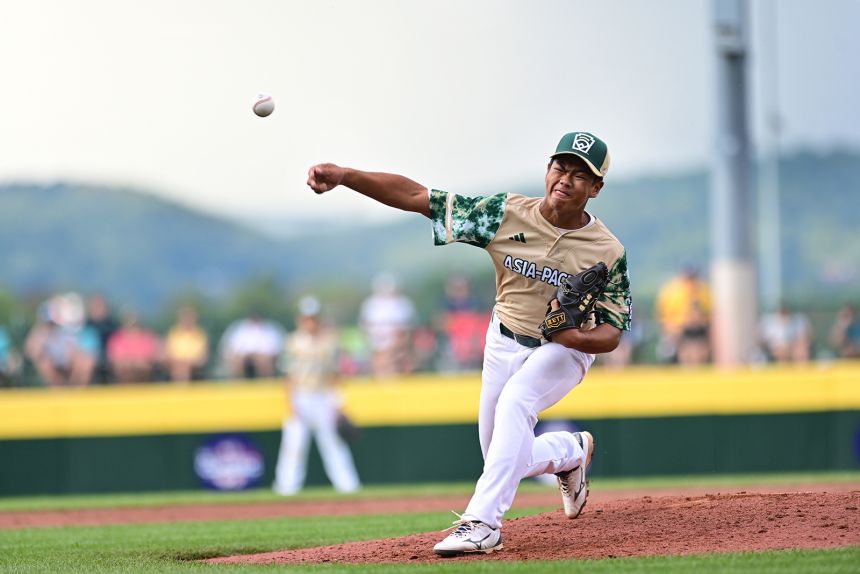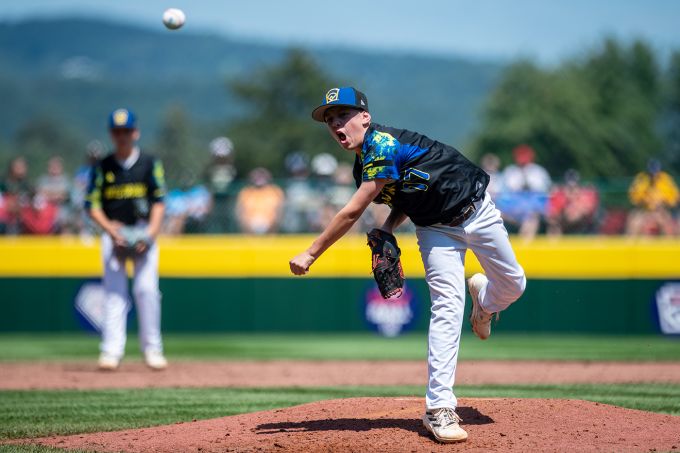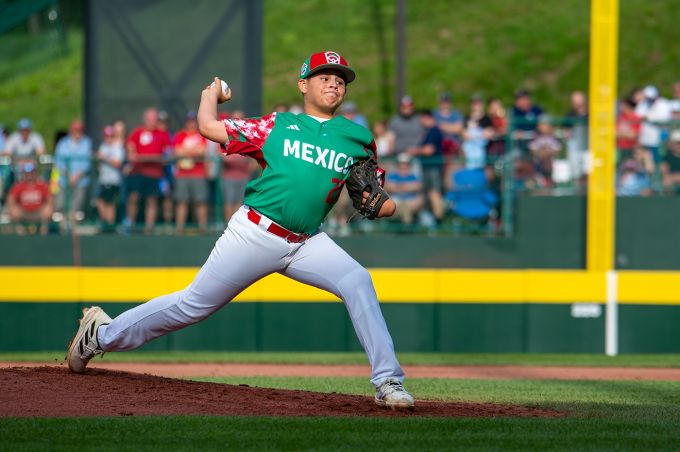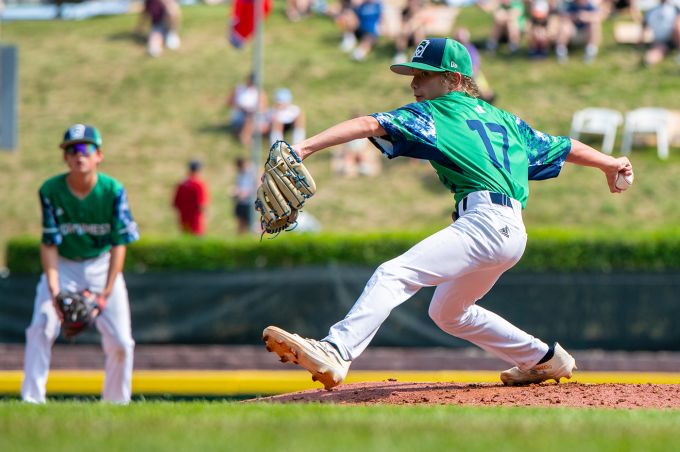December 09, 2023
Throwing Heat
What’s the impact of a Little Leaguer throwing 81 mph on the sport?

Taiwan starting pitcher Fan Chen-Jun delivers a pitch against Canada on Aug. 17, 2023, during the Little League World Series in South Williamsport, Pa.
Credit: Caleb CraigSOUTH WILLIAMSPORT, Pa. — The pitcher watched the signs from his catcher, gave the nod and started his windup, sending the ball rocketing toward the plate.
THWAMP. The sound of the catcher’s glove echoed in the stadium. It clocked at 80 mph.
Another pitch. THWAMP. Eighty-one mph.
In a Major League Baseball game where fastballs often reach 100 mph, that might be the velocity of an off-speed pitch. But this was the Little League World Series, and the pitcher was not a star in his mid-20s but a 12-year-old boy — Taiwan’s Fan Chen-Jun.
Fan was the talk of the 2023 Little League World Series thanks to his dominant performances on the mound and his blazing fastball, the hardest a kid had thrown in the summer festival’s 76 years.
He was the first to break the 80-mph threshold, but he won’t be the only one. Others will follow. Fan has started a Little League arms race, with teams scrambling to have one of their players be as dominant on the mound as the 5-foot-8 right-hander.
At the same time, the sport is facing some serious questions: Is it fair for a 12-year-old to throw 80 mph on a kid-sized field? Is it healthy for the young pitcher’s arm? How is this even possible?
Stronger and stronger
ESPN Little League and MLB commentator Jessica Mendoza said she had to double-check she was at Williamsport and not at an MLB ballpark when she saw Fan pitch.
“It looked like 100 mph, like something you would see in the big leagues,” Mendoza said. “You kind of had to blink, like, ‘Wait a second am I watching the big leagues or Little League?’”
Obviously, Fan wasn’t throwing 100 mph. But with the shorter distance from the mound to the plate — 46 feet versus 60 feet, 6 inches — Fan’s pitches looked that fast to tween hitters.
Mendoza said she’d never seen anyone throw that hard before at that age, but she said it was inevitable that a kid would eventually throw close to 80 mph.
“I think it’s progression,” said Mendoza, who starred for the U.S. softball team at two Olympics. “Kids weren’t throwing 70 mph. We rarely saw that, but now we’re seeing more of that now. That was such a rarity just a few years ago. Kids are bigger, faster, stronger. They are taught to show max effort and that’s definitely where it’s headed.”
There’s been a natural progression in almost every sport as training technology gets better and athletes work harder. The past 10 100-meter dash records have come in the last 20 years, even though the event has been held on a world stage since at least the 1890s.
“Do we want to tell kids not to get stronger not to improve? No,” Mendoza said. “I think the game will evolve as we see the progression of its athletes. That's what we've seen over time. If you look back into history, that's exactly what happens. Pretty much in every professional sport.”
“I think it’s progression,” said Mendoza, who starred for the U.S. softball team at two Olympics. “Kids weren’t throwing 70 mph. We rarely saw that, but now we’re seeing more of that now. That was such a rarity just a few years ago. Kids are bigger, faster, stronger. They are taught to show max effort and that’s definitely where it’s headed.”
There’s been a natural progression in almost every sport as training technology gets better and athletes work harder. The past 10 100-meter dash records have come in the last 20 years, even though the event has been held on a world stage since at least the 1890s.
“Do we want to tell kids not to get stronger not to improve? No,” Mendoza said. “I think the game will evolve as we see the progression of its athletes. That's what we've seen over time. If you look back into history, that's exactly what happens. Pretty much in every professional sport.”
How does at 12-year-old throw 80 mph?
Wake Forest pitching coach Mike McFerran, who specializes in pitching mechanics, said throwing hard is about the snap a pitcher has when the lower body loads and fires, allowing for the arm to simply follow through.
“Fan checks all those boxes,” McFerran said. “We also look for ankle stability and pelvic stability throughout the delivery. It seems Fan does this exceptionally for his age.”
However, throwing 80-plus mph at 12 years old does have its drawbacks, injury risk being the biggest.
85 pitches
Little League pitchers are limited to 85 pitches per game as part of an effort to prevent injuries.
Right now, no one is allowed to throw more than 85 pitches in a game, but the rule was made in 2006 and players are throwing a lot harder than they were then.
The pitch count in Little League was enacted to prevent arm injuries in younger players, the most notable being Tommy John surgery or ulnar collateral ligament reconstruction.
According to a study in 2017, published in Sports Health, “there was a significant relationship between elbow injury and elbow valgus torque and shoulder maximum external rotation torque,” among 23 professional baseball pitchers.
Tom Whipple, a physical therapist for over 30 years in the State College area, disagrees with hard-and-fast rules that no 12-year-old should throw the ball 75 and 80 mph. He said many things go into injuring the ulnar collateral ligament, and velocity is only a factor when core strength, throwing motion and lower body strength cannot support it.
But he does acknowledge an injury can be calamitous to a child’s elbow. Whipple said if the child’s bones are not fully ossified then there is a greater risk of permanently damaging the arm compared to a professional pitcher, whose growth plates are fully formed.






Kids are still kids
Australia’s manager, Brad Abel said Fan’s 80-mph pitches were something he’d never seen, and he said his team saw nothing like them in games in Australia leading up to the tournament. He said his players were scared of the ball, and he thought that could have played a role in their early exit from the tournament.
What’s it like to catch a fastball from just that 81 mph from just 46 feet away? Fan’s catcher, Chen Kai-Sheng, said it hurts.
“It’s very tough to be Fan’s catcher,” Chen said through a translator. “It’s not easy to be Fan’s catcher.”
Though he was the talk of the Little League World Series, Fan was humble. After his debut at the LLWS in August, featuring a 6-0 no-hit shut out of Canada from the mound and a line drive home run at the plate, he still said pitching was harder than getting into the batter’s box.
“I haven’t pitched in four days,” Fan said after his mound appearance. “Sometimes, I might be out of sync.”
It can, indeed, happen. And regardless of how hard they throw, Little Leaguers are still 9- to 12-year-olds.
Fan finally had a bad day at the wrong time in the Little League tournament. Taiwan went to the bullpen to bring in Fan to face the top of Curacao lineup in the semifinal, the international championship.
Fan hadn’t allowed a hit all tournament with his off-speed and blazing fastball, but it wasn’t enough.
Curacao played small ball on him, stringing together a couple of hits that turned into two runs. The final score: Curacao 2, Taiwan 0.
“Throughout my coaching career, I understand that these are kids,” Taiwan manager Lee Cheng-Ta said. “You cannot expect them to be adults or like the MLB. They are not stable, and you can’t put the blame on them. They are just kids.”
In the end, Taiwan had to settle for third place in the tournament after beating Texas 10-0 in the consolation game.
But Fan gave players, coaches and fans a look at the future.

Twelve-year-old Taiwan starting pitcher Fan Chen-Jun threw harder than any pitcher in the 76-year history of the Little League World Series.
Credit: Caleb Craig